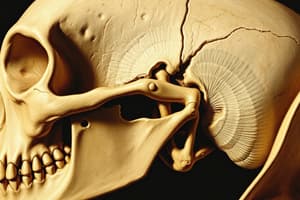Podcast
Questions and Answers
What is the main difference between cortical bone and cancellous bone?
What is the main difference between cortical bone and cancellous bone?
- Cancellous bone contains no blood vessels.
- Cortical bone is denser and forms the tough outer layer. (correct)
- Cancellous bone is primarily found in the outer layer of bones.
- Cortical bone is softer than cancellous bone.
Which type of cells are responsible for breaking down the extracellular matrix in bone?
Which type of cells are responsible for breaking down the extracellular matrix in bone?
- Osteocytes
- Osteoclasts (correct)
- Bone lining cells
- Osteoblasts
What is the primary function of osteoblasts?
What is the primary function of osteoblasts?
- To resorb bone tissues and release minerals.
- To secrete extracellular matrix and support bone formation. (correct)
- To line the surfaces of bones.
- To maintain the extracellular matrix.
What distinguishes immature bone from mature bone?
What distinguishes immature bone from mature bone?
Which of the following components is non-mineralized in the bone structure?
Which of the following components is non-mineralized in the bone structure?
What role do osteocytes serve in bone health?
What role do osteocytes serve in bone health?
Which statement about bone lining cells is correct?
Which statement about bone lining cells is correct?
What is the main mineralized component of bone?
What is the main mineralized component of bone?
What structure of bone is known for its concentric rings?
What structure of bone is known for its concentric rings?
Which of the following is a factor that influences the duration of fracture repair?
Which of the following is a factor that influences the duration of fracture repair?
What is the role of osteoprogenitor cells in the healing process?
What is the role of osteoprogenitor cells in the healing process?
Which process begins after approximately 1 week during fracture healing?
Which process begins after approximately 1 week during fracture healing?
What type of tissue forms during the inflammatory stage of fracture repair?
What type of tissue forms during the inflammatory stage of fracture repair?
What phase of fracture healing involves the resorption of excessive callus?
What phase of fracture healing involves the resorption of excessive callus?
What are Volkmann's canals primarily responsible for?
What are Volkmann's canals primarily responsible for?
What occurs during the endochondral ossification phase of fracture healing?
What occurs during the endochondral ossification phase of fracture healing?
Flashcards are hidden until you start studying
Study Notes
General Structure of Bone
- Cortical bone (compact bone) serves as the tough outer layer and constitutes the majority of the bone in the body.
- Covered by a periosteum that contains blood vessels for nourishment.
- Cancellous bone (trabecular/spongy bone) features a spongy, mesh-like structure and is in contact with bone marrow.
Cellular and Non-Cellular Components of Bone
-
Cellular Component:
- Osteoblasts are immature bone cells that secrete extracellular matrix, contributing to the bone's material properties, which can differentiate into osteocytes, bone lining cells, or undergo apoptosis.
- Osteocytes are mature bone cells, responsible for maintaining the extracellular matrix and responding to mechanical and hormonal stimuli.
- Osteoclasts break down extracellular matrix, releasing minerals into the bloodstream and creating space for osteoblasts.
- Bone lining cells provide a protective layer on bone surfaces.
-
Non-Cellular Component:
- Non-mineralized component includes osteoid, primarily composed of collagen.
- Mineralized component consists of hydroxyapatite, which provides strength and structure to bone.
Classifications of Bone Based on Maturity Level
- Immature bone, or woven bone, known as primary bone, is found during fracture repair and fetal growth. It has an irregular collagen structure and is weaker due to less mineral content.
- Mature bone, also known as lamellar or secondary bone, is formed during the remodeling process and is stronger than woven bone. It features an osteon structure with concentric rings, osteocytes housed in lacunae, Haversian canals containing blood vessels, and Volkmann’s canals connecting osteons.
- Both cortical and cancellous bones can present in immature forms.
Process of Fracture Repair
-
Fracture repair involves regeneration and remodeling, with no scar formation and a return to optimal function possible.
-
Healing duration varies based on factors such as fracture site, type, treatment, soft tissue involvement, and individual considerations including age and nutritional status.
-
Phases of Healing:
- Initial Response: Internal bleeding delivers cells to the injury site, secreting growth factors and subsequent clotting. Key cell types involved include fibroblasts, platelets, osteoprogenitor cells (bone precursor cells), mesenchymal cells (can differentiate into various cell types), and inflammatory cells.
- Hematoma Formation: Lasts approximately one week, providing a foundation for healing.
- Inflammation Phase: Granulation tissue forms alongside fibrosis and neovascularization (new blood vessel formation).
- Soft Callus Formation: Begins around two weeks. Osteoclasts clear necrotic bone, while periosteum and endosteum regenerate into hyaline cartilage (soft callus) and bony spicules (hard callus) to immobilize the fracture.
- Hard Callus Development: Starts more than a week after soft callus formation, involving fibrocartilage and endochondral ossification, turning cartilage into bone.
- Remodeling Phase: Can take months to years, replacing woven bone with lamellar bone, resorbing excess callus, and reshaping bone in response to mechanical stresses according to Wolff’s Law.
Studying That Suits You
Use AI to generate personalized quizzes and flashcards to suit your learning preferences.




